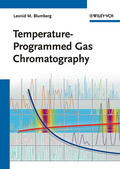Temperature-Programmed Gas Chromatography

1. Edition October 2010
XX, 340 Pages, Hardcover
86 Pictures
32 tables
Monograph
Short Description
A comprehensive up-to-date overview of temperature-programmed gas chromatography (GC), covering the basics concepts of GC and its mathematical and physical background, followed by a discussion of the different aspects in the formation of a chromatogram.
Buy now
Price: 145,00 €
Price incl. VAT, excl. Shipping
Euro prices for Wiley-VCH and Ernst & Sohn titles are only valid for Germany. In EU countries, local VAT applies. Postage will be charged.
- Out of print -
This book provides a comprehensive up-to-date overview of temperature-programmed gas chromatography (GC). The first part of the book introduces the reader to the basics concepts of GC, as well as the key properties of GC columns. The second part describes the mathematical and physical background of GC. In the third part, different aspects in the formation of a chromatogram are discussed, including retention times, peak spacing and peak widths.
An invaluable reference for any chromatographer and analytical chemist, it provides all the answers to questions like:
* At what temperature does a solute elute in a temperature-programmed analysis?
* What is the value of the retention factor of eluting solute?
* How wide are the peaks?
* How large is the time distance between two peaks?
* How do all these parameters depend on the heating rate?
PART I: Introduction
BASIC CONCEPTS AND TERMS
A COLUMN
Retention Mechanisms
Structures
Operational Modes
Specific and General Properties of a Column
Boundaries
PART II: Background
LINEAR SYSTEMS
Problem Review: Metrics for Peak Retention Time and Width
Chromatograph as an Information Processing System
Properties of Linear Systems
Mathematical Moments of Functions
Properties of Mathematical Moments
Pulses
MIGRATION OF A SOLID OBJECT
Velocity of an Object
Parameters of Migration Path
Relations between Path Parameters and Object Parameters
SOLUTE-LIQUID INTERACTION IN GAS CHROMATOGRAPHY
Distribution Constant and Retention Factor
Chromatographic Parameters of Solute-Liquid Interaction
Alternative Expressions of Ideal Retention Model
Linearized Retention Model
Relations between Characteristic Parameters
MOLECULAR PROPERTIES OF IDEAL GAS
Theory
Gas Viscosity and Related Parameters - Empirical Formulae
Empirical Formulae for Solute Diffusity in a Gas
FLOW OF IDEAL GAS
Mass-Conserving Flow
Pneumatic Parameters
Relations Between Pneumatic Parameters
PART III: Formation of Chromatogram
FORMATION OF RETENTION TIMES
Solute Mobility
Solute-Column Interaction and Solute Migration
General Equations of a Solute Migration and Elution
Uniform Solute Mobility in Isobaric Analysis
Scalability of Retention Times in Isobaric Analyses
Dimensionless Parameters
Boundaries of Linearized Model
FORMATION OF PEAK SPACING
Static GC Analysis
Closely Migrating Solutes in Dynamic Analysis
Isobaric Linear Heating Ramp and Highly Interactive Solutes
Properties of Generic Solutes
FORMATION OF PEAK WIDTHS
Overview
Local Plate Height
Solute Zone in Non-Uniform Medium
Apparent Plate Number and Height
Thin Film Columns
Thick Film Columns
Temperature-Programmed Analyses
Temperature-Programmed Thin Film Columns
Packed Columns
Scalability of Peak Widths in Isobaric Analyses
Plate Height: Evolution of the Concept
Incorrect Plate Height Theory
After leaving HP in 1998, Dr. Blumberg founded a consulting company, Fast GC Consulting, and continued the development of theoretical foundation for optimization of conventional, fast and multi-dimensional GC where he is a world leading expert.
Leonid Blumberg authored 50 scientific publications and patented 19 inventions.


